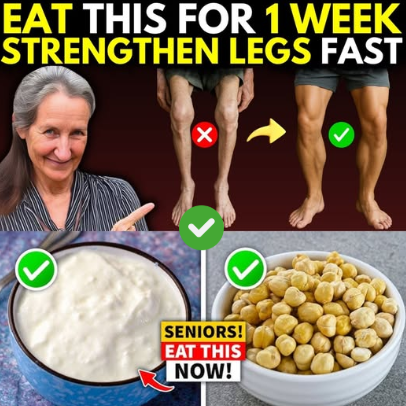
Introduction
Aging doesn’t just show up in the mirror with wrinkles or gray hair—it quietly creeps into your legs. Suddenly, climbing stairs feels harder, standing from a chair takes more effort, and walks that were once a breeze can feel exhausting. The truth is, declining leg strength is one of the earliest and most overlooked signs of aging. But here’s the good news: the solution isn’t always found in a pill bottle. Sometimes, it’s already waiting in your kitchen.
The Power of Nutrition After 60
After the age of 60, our bodies naturally lose muscle mass, a condition known as sarcopenia. This gradual decline leads to weakness, slower mobility, and a higher risk of falls. But food—when chosen wisely—can become your most powerful ally. Nutrient-dense meals rich in protein, vitamins, and minerals can help rebuild leg strength, improve circulation, and keep you moving with confidence.
Let’s dive into the top 15 foods that seniors should add to their diet to support strong, resilient legs and an active lifestyle.
Lean Beef: A Protein Powerhouse
Lean beef is packed with protein and creatine, both essential for rebuilding and maintaining muscle strength. Choosing grass-fed beef adds another advantage—extra omega-3s to fight inflammation that often comes with aging joints.
Salmon: Joint and Muscle Support
Salmon is a superstar for its omega-3 fatty acids and vitamin D. Together, they reduce joint stiffness, aid recovery, and strengthen bones, making every step easier and smoother.
Eggs: Nature’s Complete Protein
Eggs deliver all nine essential amino acids, making them one of the best foods for muscle repair. Plus, they’re rich in vitamin B12, which supports healthy nerves—critical for strong, coordinated leg movement.
Cottage Cheese: Slow-Burning Muscle Fuel
Cottage cheese is rich in casein protein, which digests slowly, providing your muscles with a steady stream of nutrients. Eating it before bed helps your legs repair and rebuild while you sleep.
Spinach: The Green Muscle Booster
Spinach isn’t just for Popeye—it’s a leg-friendly powerhouse. High in magnesium and natural nitrates, spinach improves blood flow and supports stronger, more efficient muscle contractions.
Lentils: Plant-Based Strength
Lentils deliver protein and iron, helping transport oxygen to your leg muscles. This keeps fatigue at bay and boosts endurance for daily activities.
Video : Over 60? 8 Collagen-Rich Foods to Reduce Leg Swelling and Strengthen Joints
Almonds: Anti-Inflammatory Snack
A handful of almonds offers magnesium, protein, and healthy fats. These nutrients work together to reduce joint inflammation and speed up post-exercise recovery.
Sweet Potatoes: Natural Energy Supply
Sweet potatoes are loaded with complex carbohydrates and potassium, giving your legs a steady fuel source while preventing cramps and fatigue.
Bananas: Cramps Be Gone
Bananas are a simple but effective solution for leg cramps. Their high potassium content supports muscle contractions and keeps painful spasms away.
Greek Yogurt: Protein Meets Probiotics
Greek yogurt blends protein with probiotics, which help your body absorb nutrients more effectively. Stronger digestion means your muscles get the fuel they need to thrive.
Broccoli: Bone and Joint Protector
Broccoli is rich in vitamin C, calcium, and antioxidants. These nutrients protect bones, strengthen connective tissue, and help you stay mobile as you age.
Chia Seeds: Tiny But Mighty
Chia seeds may be small, but they pack a punch—fiber, protein, calcium, and omega-3s all in one. They’re excellent for maintaining muscle health and supporting flexible joints.
Chicken Breast: Lean Muscle Builder
Chicken breast is a lean, protein-rich food that supports muscle growth without unnecessary fats. After light exercise, it’s perfect for repairing and strengthening leg muscles.
Fortified Milk: Strong Bones, Strong Legs
Fortified milk provides calcium and vitamin D, essential nutrients for preventing bone loss and reducing fracture risks. Strong bones mean strong legs.
Oranges: Collagen Support for Mobility
Vitamin C in oranges plays a critical role in collagen production. Collagen strengthens tendons and ligaments, the “wires and cables” that keep your legs moving with ease.
How to Build a Leg-Strengthening Daily Meal Plan
The secret isn’t eating all 15 foods at once—it’s mixing and matching them throughout your day. Here’s a sample plan:
- Breakfast: Greek yogurt with banana slices and chia seeds
- Lunch: Grilled chicken breast with spinach salad and a side of lentils
- Dinner: Baked salmon with roasted sweet potatoes and steamed broccoli
- Snacks: Almonds, cottage cheese, or a hard-boiled egg
Pair this meal plan with daily movement—light strength training or a 20-minute walk—and you’ll supercharge your leg health.
Video : Over 60? Eat This First or Your Leg Muscles Will Keep Wasting Away || DR ALAN MANDELL
Final Thoughts: Don’t Wait Until It’s Too Late
Strong legs aren’t just about exercise—they’re about what’s on your plate. After 60, your independence depends on your ability to move confidently, prevent falls, and stay active. By adding these 15 foods to your daily diet, you give your body the tools it needs to maintain muscle, improve circulation, and keep your legs strong for years to come.
Think of every meal as an investment in your mobility. Start today, and your future self will thank you with every step you take.


